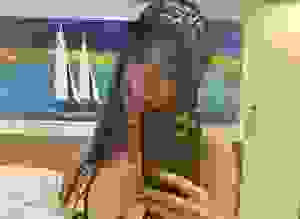- Reviews & Essays
- What Squirt Actually Is
Note: You can change font size, font face, and turn on dark mode by clicking the "A" icon tab in the Story Info Box.
You can temporarily switch back to a Classic Literotica® experience during our ongoing public Beta testing. Please consider leaving feedback on issues you experience or suggest improvements.
Click hereDisclaimer: The following is for informational purposes only. Actually, just to be safe, no one should read this article. Thanks.
At a glance:
-Squirt is clear, odorless, and tasteless and contains PSA (female come).
-Urine is yellow, stinks, tastes horrible, and does not contain PSA.
-All true squirt is well over 99% water and contains only insignificant trace urine chemicals.
-Urine can be almost as low as 90% water and up to nearly as much as 10% urine chemicals.
-Mere diluted urine is not the same as squirt since diluted urine has significant urine chemical levels and does not contain PSA.
-Squirt is basically just water with imperceptibly low levels of trace urine chemicals. It is not the same as urine since it is too different on both the perceptual, experiential level, and on the chemical level.
-Any fluid that is closer to, or identical to urine, due to having less than 99% water, and which therefore could not possibly be clear, odorless, and tasteless, is not squirt. Thus, any test that shows squirt is chemically identical to normal urine was not testing squirt in the first place.
So, squirt is clear, odorless, and tasteless and contains PSA (female come) (1, 6, 10). Yet, some say squirt is urine. In debate, a study, like the one by Salama (5), will usually be brought out where they tested the squirt of some women and found it to be the same as normal urine. Something very strange is obviously going on, because normal urine is yellow, foul smelling, and tastes horrible. So, how could these things possibly be the same thing?
Well, other studies have shown completely different results. For example, Addiego showed that the squirt in his study didn't share any chemicals with urine at all, but still contained PSA (1, 9)*. This, while Schubach showed that all of the women in his study had massive reductions in urine chemicals, as high as an 86% reduction for urea, and an 89% reduction for creatine (4). These were the only two chemicals assessed, and, since they are the most prevalent, then assuming a similar reduction of the average of these two for all urine chemicals, then all of the urine chemicals would be reduced by 87%. Since normal urine of an adequately hydrated woman is 96% water, and 4% urine chemicals (2), that would mean that reducing that 4% by 87% would put the final numbers at 99% water and a mere insignificant 0.52% urine chemicals!
This means that true squirt is pretty much water because the urine chemicals are so reduced as to be virtually non-existent and in no way noticeable. Squirt that is 99.48% water is indistinguishable to the senses from fresh, natural water found in a stream or similar. This is true squirt.
Even if we took just the average reduction for urea, which is the most prevalent chemical in urine, at 50% of the urine chemicals (2), and also the smelliest and most offensive to the senses, the average of all subjects was still a 72% reduction. This, at 50% of the urine chemicals, being 2% of the total 4%, would mean the final number for urea would be much less than 1%, at 0.56%. Thus, even if we go off of the average reduction, rather than the higher reduction numbers found, it is still a massive change, and the most relevant, and most noticeable chemical is reduced to an insignificant, and unnoticeable amount.
Obviously the other chemicals would be reduced at similarly large rates, or reduced at even higher rates, which is apparent when we note that urochrome, which makes urine yellow, must be reduced to an insignificant amount, because squirt is clear. Hence, the two chemicals that make urine what it is to our senses are almost non-existent in squirt. On a sensory level, they are imperceptible.
We might imagine what would happen if Schubach had studied the women further, and had them drink a safe amount of water up to the amount that would dilute their urine as in a study on urinalysis of diluted urine (3) (This is extremely dangerous to attempt, and should NOT be done! Drinking too much water can be lethal. I'm hypothetically imagining what would happen if a scientist, with the professional knowledge to do it safely, did the experiment. NO ONE SHOULD ACTUALLY TRY ANYTHING LIKE THIS). If this were done, and the women were then aroused into orgasming and producing squirt, considering normal squirt already can be as high as 99% water and only 0.52% urine chemicals, and that the average of the reduction of urea and creatine of those studied was nearly a 75% reduction (4), it is perfectly reasonable to assume that further reducing the chemicals via hydration would be approaching a fluid that is virtually free of urine chemicals entirely. This is because their squirt would have been reduced in urine chemicals at the level caused by hydration, and then further by the natural process of squirting. This kind of squirt would certainly have an even higher amount of water and less urine chemicals.
This would mean that a woman who would normally produce the highest water, and lowest urine chemical squirt found in the study (99.48% water, 0.52% urine chemicals) would likely produce virtually only water at this level of hydration. Any woman who would normally produce squirt with slightly more urine chemicals, as found in the study (72% reduction average for urea, 76% for creatine), would, instead, at this level of hydration, likely produce squirt closer to the normal hydration high end of 99.48% water, and 0.52% urine chemicals. Meaning this kind of hydration would have all participants in the study squirting a very pure form of squirt.
In other words, since it is rational to assume that this study is representative of women in general, we may assume that all true hydrated squirt is well over 99% water, and contains only a tiny, insignificant trace of urine chemicals.
So, what happened with these studies? Well, Schubach made clear that in his study the women drained themselves of urine and it was tested, then the women sexually stimulated themselves for an hour, then they drained again, and the fluid was tested again, and finally they orgasmed and squirted, and this fluid was tested yet again. He found massive reductions of chemicals in the second test, and sometimes a further reduction in the third test.
This, probably, is the key. Perhaps in the Salama study the women came too quickly, and/or they weren't turned on enough, and/or the time between initial bladder emptying and subsequent arousal was too long, and so they just peed to satisfy the study.
What is clear is that women who are squirters, and are actually in the mood, and properly aroused squirt almost entirely water, with a small amount of PSA, and trace urine chemicals, as per Schubach, or a fluid with zero urine chemicals, and with a small amount of PSA, per Addiego.
Of course, maybe Salama, who found squirt to be normal urine, and others who had similar results just found women who aren't true squirters somehow by accident? Maybe the women in their studies aren't even capable of producing squirt, and always urinate during orgasm, no matter how aroused they are? Who knows? But no one calls normal, stinky, yellow urine "squirt," so, whatever they were testing wasn't squirt in the first place, obviously. Rather they tested normal urine and declared that it was normal urine. Not particularly interesting.
Any true squirt would certainly be found to have dramatically reduced urine chemicals, because otherwise it would be impossible for it to be clear, odorless and tasteless. We all know what normal urine looks and smells like, and that it is quite the opposite of clear, odorless and tasteless, so this is an obvious and undeniable point, and is backed up by the other studies which have demonstrated this huge reduction, like the one by Schubach, and the other by Addiego.
That clears that up, and we can safely say that, no, squirt is not urine.
But isn't it urine on some technical level?
Some will point out that some studies say it is technically urine, and, thus, so must we all.
Well, is that really true? Must we all talk like scientists? Is the way they talk really applicable to daily life, or might it even create problems, and absurdities to do so?
Scientists doing studies may call it "urine" even if it were 99.999999% water, because they are scientists, and that is technically correct, due to the source of the fluid coming from the bladder, ureters, etc.
But, for all intents and purposes of the rational, commonsense, everyday world, a liquid that is almost entirely water, at over 99%, and contains mere trace urine chemicals, is just water, or, in this case, it's just squirt. Just like when we say tap water is water, even though it has such and such trace chemicals, including urine chemicals (8).
Saying it is the same thing because of this technicality is asinine. Imagine a woman saying she squirts and then pisses all over your bed, ruining the mattress with a stinky, yellow stain.
Now imagine you've bought a new mattress, and meet a different woman who says she squirts and a few ounces of pretty much just water squirt out of her, and just dry with zero problems. Your mattress is unharmed.
If squirt is urine, then these events were the exact same thing, despite the reality being that one woman damaged your property, and offended your senses, and the other didn't, due to the stark, objective differences in the chemical makeup and sensory qualities of the liquids. How absurd to call them the same thing!
The studies sometimes call squirt something like "diluted and changed urine," but that's because they are the most technical literature, and they also acknowledge and clearly state that there are significant chemical differences and reductions. In daily life, we don't talk like that, and for the very good reason that it would be ridiculous and very confusing.
Studies on seafood would also point out that deveined shrimp still has small amounts of shrimp waste in it, despite being marketed as having the waste removed. Studies on dairy may point out that cow's milk is technically changed blood, and any other number of wild points that are accurate on a technical level.
We could find countless examples where studies point out technically true things that are not relevant to normal life due to being insignificant to normal sensory experience. Yet, in normal speech, these things are all too different for us to use the same words to describe them.
Being served a bottle of blood when milk was requested at a restaurant would be ridiculous, even though they're technically similar in some sense, just as being served a mess of yellow, stinking urine in the bedroom would be ridiculous when a woman says she squirts.
So, that's why clear, odorless, tasteless orgasm liquid from a woman is called "squirt," and not "urine."
This brings up the question of whether or not a woman who simply drinks a lot of water would have urine that was the same as squirt, thus lending credence to the position that squirt is merely "diluted urine," as some studies call it.
The answer is no. In a study, where the subjects drank as much water as safely possible for four hours, the reduction of urine chemicals in their tested urine was still nowhere near as extreme as what was found with the squirt in the Schubach study (again, drinking too much water can be fatal! No one should try this kind of thing!) (3). Also, of course, squirt contains PSA, and mere extra hydrated urine does not.
Thus, we see that squirt is a unique fluid only produced by arousal and orgasm by some women and is not the same as mere diluted urine.
So, logically speaking, here, again, as with every other point on the isssue, calling "squirt" "pee" or "urine" doesn't make any sense, since it's totally different, due to having a completely changed chemical makeup, utterly different sensory qualities, and very different consequences to one's life.
Really, the studies that demonstrated huge reductions in chemical makeup shouldn't call it "diluted urine" either, with the above in mind, since it is so misleading. Indeed, we see that some studies do refrain from calling it "urine," and simply call it "fluid" (9), and even the ones that do call it "diluted urine" sometimes switch back and forth between calling it "diluted urine," and something more accurate, like "diluted fluid" (7).
Conclusion:
Squirt is a unique sexual fluid that is up to 99.48% water, contains PSA, and has insignificant quantities of urine chemicals, or sometimes has zero urine chemicals.
This clearly does not describe urine, which is 96% water, 4% urine chemicals, or almost as low as 90% water and up to nearly 10% urine chemicals, and does not contain PSA. This also does not describe diluted urine, which still contains significant urine chemicals in higher quantities than squirt, and does not contain PSA.
So, at what point is the dividing line? At what point do we say that the hot juices shooting out of a woman are "squirt," and that calling it "urine" would be ridiculous?
The answer is: At the point that the urine chemicals that distinguish it from water become reduced to mere trace amounts, which are not detectable to the senses under normal conditions (without laboratory equipment).
Also, Pastor points out that squirt and coital incontinence are completely different phenomena. Women with coital incontinence "leak" urine throughout coitus, and it can cause them psychological distress (1). By stark contrast, squirters just squirt a few ounces of pretty much just water during orgasm only, and women asked about how squirt affected their lives generally agreed that squirt is enjoyable for them and their partners, and enhanced their sexual lives (12).
So, in conclusion, is squirt urine? Nope. Squirt is closer to tap water than urine. Tap water, like squirt, is over 99% water, but also contains insignificant amounts of urine chemicals, like urea (8).
The trolls saying "squirt is pee" in comment sections all over the place should be reminded that, by their own flawed logic of denying differences based on chemicals that are so low that they are imperceptible without laboratory equipment, they should also be commenting "tap water is pee," on posts about tap water.
In fact, in the case of squirt that has zero urine chemicals, like in the Addiego study, squirt actually then would have less urine chemicals than tap water! Squirt is truly an amazing thing!
1.) Zlatko Pastor, Roman Chmel. Differential diagnostics of female "sexual" fluids: a narrative review. 2017
2.) C. Rose, A. Parker, B. Jefferson, and E. Cartmell. The Characterization of Feces and Urine: A Review of the Literature to Inform Advanced Treatment Technology. 2015
3.) E J Cone, R Lange, W D Darwin. In vivo adulteration: excess fluid ingestion causes false-negative marijuana and cocaine urine test results. 1998
4.) Gary Schubach. Urethral Expulsions During Sensual Arousal and Bladder Catheterization in Seven Human Females. 2001
5.) Samuel Salama, Florence Boitrelle, Amélie Gauquelin, Lydia Malagrida, Nicolas Thiounn, Pierre Desvaux. Nature and origin of "squirting" in female sexuality. 2015
6.) Beverly Whipple. Ejaculation, Female. 2014
7.) Aberto Rubio-Casillas, Emmanuele A Jannini. New insights from one case of female ejaculation. 2011.
8.) Aisha S. Dickerson, Janice S. Lee, Channa Keshava, Andrew Hotchkiss, Amanda S. Persad. Assessment of Health Effects of Exogenous Urea: Summary and Key Findings. 2018
9.) Frank Addiego, Edwin G. Belzer Jr., Jill Comolli, William Moger, John D. Perry &Beverly Whipple. Female ejaculation: a case study. 1980
10.) Zlatko Pastor, Roman Chmel. Female ejaculation and squirting as similar but completely different phenomena: A narrative review of current research. 2022
11.) Joanna B. Korda, Sue W. Goldstein, Frank Sommer. SEXUAL MEDICINE HISTORY: The History of Female Ejaculation. 2010
12.) Florian Wimpissinger, Christopher Springer, Walter Stackl. International online survey: female ejaculation has a positive impact on women's and their partners' sexual lives. 2013
*At the time the Addiego study (9) was conducted "female ejaculation" was a blanket term that was used for all female sexual expulsions (1). What we call "female ejaculation" today comes from the Skene's gland (1), not the urethra. Female ejaculate is a small amount, usually around a mere teaspoon, of odorless, sweet tasting, thick white fluid (1). Whereas squirt is a large amount of odorless, tasteless, clear fluid that is almost entirely water (1). However, due to this archaic blanket use of the term "female ejaculation," and the total non usage of the term "squirt" in that study, the squirt was called female ejaculation. However, it was stated that it came from the urethra (9), which is where squirt comes from, and the liquid was analyzed to ensure that it was not urine, and certainly this would not have even been considered if it were a mere teaspoon of thick white liquid that did not come from the urethra in the first place. Obviously, this is why Pastor included this study alongside others about squirt.








